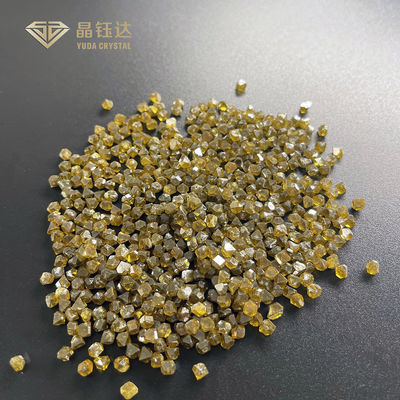Yellow 3.4mm Synthetic Single Crystal Hpht Diamonds For Industrial Applications
Single Crystal Hpht Diamonds Description
Lab diamonds are real diamonds. Carbon is the main element of natural and laboratory-grown diamonds. The chemical and physical properties of synthetic diamonds are same as natural diamonds in terms of hardness, thermal conductivity, and strength.
High temperature and high pressure (HPHT) and chemical vapor deposition (CVD) are the two most commonly used growth methods in synthetic diamonds industrial. High temperature and high pressure exert intense heat (about 1500 degrees Celsius, or 2700 degrees Fahrenheit) and pressure (1.5 million pounds per square inch) on the diamond seed and the carbon atoms surrounding it. Chemical vapor deposition, on the other hand, uses less heat and pressure, but introduces a mixture of chemical gases, which decomposes and hardens into crystalline carbon atoms.
Diamond is the most stable material in density. Because of its simple chemical composition and compact structure, the density of transparent diamond has the greatest stability, and the range of density variation is only about 0.01% when it contains impurities. This characteristic is of special significance for gem identification.
Diamond is the most inert material. Thermal inertia is the nature of maintaining the thermal motion state of matter. The greater the thermal inertia, the more difficult it is to change the thermal state. Diamond has the highest thermal conductivity and the highest thermal inertia, which can not be compared with any metal and non-metallic minerals. This provides a basis for the design of thermal test instrument. It is quick and effective to distinguish diamond from other gemstones by thermal conductivity meter.
Parameters of Single Crystal Hpht Diamonds
| Single Crystal Hpht Diamonds |
| Brand Name |
Yuda Crystal |
| Name |
Single Crystal Hpht Diamonds |
| Diamond Color |
Yellow |
| Diamond Clarity |
SI-I |
| Diamond Size |
3.4mm |
| Diamond Cut |
Uncut |
| Polish |
None |
| Symmetry |
None |
| Technology |
HPHT |
| Mesh Size |
None |
| Shape |
Rough |
| Diamond Enhancement |
None |
| Available Type |
HPHT |
| Diamond Certificate |
None |
| Application |
Diamond tools making |
| Place Of Origin |
Zhengzhou, China |
| Delivery Time |
1 - 15 Working Days Base on Order Quantity |
| Payment Terms |
100% Payment In Advance |
| Payment Methods |
T/T, PayPal, Western Union, Bank Transfer |
| Shipping way |
DHL, FedEx, SF Express, UPS, EMS, TNT etc |
| M.O.Q |
Negotiable |
| Diamond Type |
Synthetic(lab created) |
| Location |
Zhengzhou, China |
| Treatments Applied |
None |
| Fire Dispersion |
0.044(Same as Natural Diamond) |
| Brilliance Refraction Index |
2.42(Same as Natural Diamond) |
| Relative Density |
3.52(Same as Natural Diamond) |
| Chemical Composition |
Carbon(Same as Natural Diamond) |
| Moh's Hardness |
10(Same as Natural Diamond) |
Synthetic HPHT Industrial Diamonds Introduction
Natural diamonds are created by nature and are the result of high temperature and pressure formed over billions of years. The Lab Grown Diamonds are produced in the laboratory, usually in a few weeks. The chemical difference between the two is same.
So how do you distinguish between Lab Grown Diamonds and natural diamonds?
There is no obvious difference between the Lab Grown Diamonds and natural diamonds. Even professional gemologists need special equipment to identify them. By zooming in, professionals will be able to discern subtle contrasts in diamond inclusions grown and mined in the laboratory.
| The Difference Between Lab Diamond And Natural Diamond |
| Properties |
Earth Mined |
Lab Created |
| Guaranteed Conflict-Free |
No |
Yes |
| Hardness (MOHS) |
10 |
10 |
| SP3 Carbon Diamond Bonds (%) |
100% |
100% |
| Internal Crystal Structure |
Face-Centered Cubic |
Face-Centered Cubic |
| Hardness Comparable |
2.42 |
2.42 |
| Relative Diversity |
3.52 |
3.52 |
| Color Diffusion |
0.044 |
0.044 |
| Color |
Various Grades |
K to D grades |
| Price |
$$$$$ |
$$$ |
Single Crystal Hpht Diamonds Details


 Your message must be between 20-3,000 characters!
Your message must be between 20-3,000 characters! Please check your E-mail!
Please check your E-mail!  Your message must be between 20-3,000 characters!
Your message must be between 20-3,000 characters! Please check your E-mail!
Please check your E-mail! 





